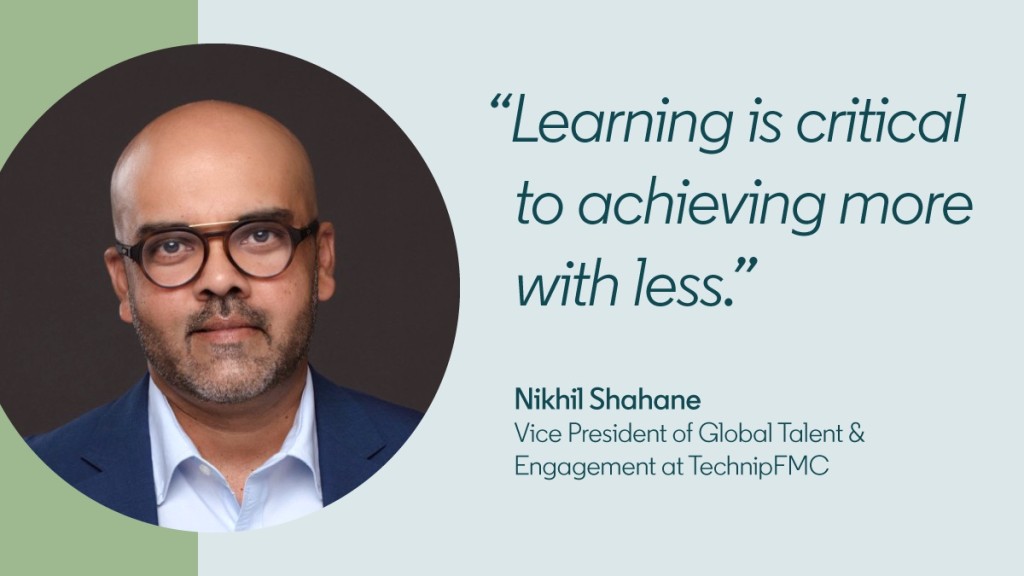A flip-flopping economy always brings budget palpitations.
But take heart — learning and development (L&D) teams have reason for confidence. You’ve already gained C-suite influence by leading your organizations through roller-coaster times.
And the continued need for agility gives you a strong business case to keep investing in people’s spirits and skills.
Here are some talking points and tactics from a global chorus of experts explaining both why it makes sense to keep your L&D budget strong and how to fend off cuts — while making the most of what you have.
Why your company should invest in learning, even when times are tough
1. Learning makes both individual employees and teams more nimble. In an economic downturn, learning is critical to helping people develop a lean mindset, says Nikhil Shahane, vice president of global talent and engagement at energy company TechnipFMC.
“Success is measured by one’s ability to change and adapt,” he points out. “Learning is critical to achieving more with less.”
And when the economy picks up, employees who’ve built new skills during challenging times will be better positioned to help your business soar.
2. Workplace safety problems can be costly. Failing to invest in training can have serious implications, says Crystal Lim-Lange, CEO of Forest Wolf, a training consultancy. Among them: more safety incidents and deviations in quality.
Crystal works with manufacturing and engineering companies and sees that quality and safety issues are on the rise. Proper training can help teams avoid problems from overwork, lack of sleep, multitasking, and shortcuts. She also sees L&D playing a key role in building psychological safety to help people speak up and report problems.
3. Great companies need great leaders. “With much of the world in turmoil,” says Andrew Saidy, vice president of talent at video game publisher Ubisoft, “companies will turn to great leaders to lead them to safety.”
Such leaders are rare, so it makes sense to build your own bench with the skills and values that match your company’s needs. “Robust leadership development is the way forward,” he says.
4. DEI commitments mustn’t falter. Devika Brij, founder and CEO of Brij the Gap Consulting, helps companies develop and retain employees from underrepresented groups. Prioritizing DEI training and development can be difficult amid hiring freezes, budget cuts, and layoffs, but Devika says you have to ask, “What values are we remaining true to?”
Organizations that immediately make cuts to DEI programs or hiring commitments will lose out on stellar employees and candidates. And those who disregard previous commitments will hurt their reputation by not practicing what they preach.
5. Investing in learning boosts your employer brand. In her work with Jobs for the Future, a nonprofit that promotes equitable economic advancement in the U.S. workforce and education systems, Cat Ward has seen firsthand how strong learning programs attract talent.
“When you invest in your people,” she says, “they see a future for themselves and a career path.” That spurs employee engagement, improves productivity and quality, and turns current employees into brand ambassadors.
And all of that positive energy is a virtuous cycle that aids future recruiting.
How to keep your learning budget strong — and show results
1. Work relentlessly with your stakeholders. Forging joint efforts across HR is a good way for L&D to create more value — and earn fans who can help champion your efforts.
“The more partnered we are, the more supportive we can be to ensure success at every point in an employee’s journey,” says Jodi Atkinson, senior director of global learning at software company Deltek.
Jodi collaborates with talent acquisition for onboarding; with business partners for performance enablement and employee engagement; and with DEI leadership for development programs that reinforce DEI foundations.
2. Weave learning into the entire employee experience. David Perring, director of research at Fosway Group, cautions that L&D teams frequently fall into the trap of perpetual heads-down learning delivery — something to be avoided if you want to deliver maximum value for your efforts.
“More L&D teams need to lift their eyes,” he says, “and think about how learning underpins the entire employee experience, across the entire employee lifecycle, and what they can do to enable that. Learning is never an end itself — it’s a means to empower.”
Taking a more holistic view of employee experience supports many important priorities, including belonging, career growth, and talent development.
3. Connect learning to business metrics. Benton McTaggart, chief people officer at Meritize, a financial services company that provides funding for skills-based education and workforce development, understands that everything is subject to cost-benefit analysis.
To bolster his ability to quantify L&D’s impact, he’s looking at more than just how well employees comprehend and retain knowledge. He’s examining how people apply new skills — like “solving complex problems and addressing conflict at work.” His ultimate goal is tracing the path from training to business results.
“It’s about digging into learning effectiveness data and finding ways to track the return on investments,” Benton says.
4. Articulate the unique value of L&D. Christopher Lind is chief learning officer for ChenMed, a primary care provider for seniors. He encourages other L&D pros to practice speaking in a compelling way about their team’s contribution.
“What L&D brings to the table,” he says, “is we fundamentally understand behavior and psychology better than other people, how to blend that with learning experiences and technology, and use that to get to the root of what you need employees to do.”
That makes L&D ideally suited to tackle sticky problems that come up more frequently during economic ups and downs.
Final thoughts: Set limits to succeed
If you do have to accept the reality of budget cuts, here’s some advice from Ubisoft’s Andrew Saidy: “Do less and practice saying no.”
“Many stakeholders,” he says, “think that L&D teams are the answer to all their needs. Saying no — while also supporting them on finding solutions, postponing needs, prioritizing projects — is key.”
It’s far better to work on a well-chosen portfolio of projects and deliver them to standards, he says, than to work on too many things, stretch your people to the point of frustration, and deliver subpar results.
Your program outcomes — and your business case in the next budget cycle — will be better for it.
For more on L&D budget trends and other data to inform your strategy, check out the 2023 Workplace Learning Report.










